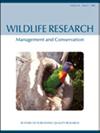评估狮子(Panthera leo)的粪便作为野狗(Lycaon pictus)在游戏农场的威慑
IF 1.6
3区 生物学
Q3 ECOLOGY
引用次数: 0
摘要
本文章由计算机程序翻译,如有差异,请以英文原文为准。
Evaluation of lion (Panthera leo) scat as a wild dog (Lycaon pictus) deterrent on game farms
ABSTRACT Context. The conservation of the Endangered African wild dog (Lycaon pictus) poses a major challenge to conservationists because outside the boundaries of protected areas, wild dogs are prone to conflict with farmers. Mitigation measures appropriate for game farmers are scarce, leaving them with limited options to reduce wild dog impact. As a result, targeted persecution is a common occurrence. However, wild dogs are subject to intraguild competition with dominant competitors, often resulting in their suppression and spatial displacement. Therefore, olfactory cues of lion presence may trigger an adverse reaction in wild dogs, and could be a means to manage wild dog movements across the landscape to prevent conflict with farmers. Aims. We aimed to evaluate whether wild dogs can be deterred by simulating lion presence. Methods. By using translocated scent cues in the form of lion scat deployed along the perimeter of plots, lion presence was simulated on game farms where lions were absent. The rate and duration of incursions by wild dogs, collared with GPS trackers, into control and treatment plots (‘group’) were evaluated. Key results. Wild dog incursion rate dropped by 55.5%, and duration of incursion events dropped by 72.7%, after lion scat was deposited. Control and treatment plots were equally affected with no significant effect of the grouping on wild dog movement. The magnitude of the treatment effect differed between packs. Conclusion. The significant decline of wild dog movement after implementation of treatment suggests a deterrence effect. The insignificant effect of group on wild dog movement indicates large-scale avoidance triggered by a change in the wild dogs’ risk perception across the landscape following treatment. The fact that the magnitude of the treatment effect differed between packs indicates that the response to predator cues is likely to be context-dependent. Implications. The findings present a novel approach to managing free-roaming wild dogs by utilising biologically relevant cues, which may benefit wild dog conservation. There is a need for further research to develop the emerging field of scent studies to provide non-lethal solutions and progress towards evidence-based large carnivore management practices.
求助全文
通过发布文献求助,成功后即可免费获取论文全文。
去求助
来源期刊

Wildlife Research
生物-动物学
CiteScore
4.30
自引率
15.80%
发文量
56
审稿时长
3 months
期刊介绍:
Wildlife Research represents an international forum for the publication of research and debate on the ecology, management and conservation of wild animals in natural and modified habitats. The journal combines basic research in wildlife ecology with advances in science-based management practice. Subject areas include: applied ecology; conservation biology; ecosystem management; management of over-abundant, pest and invasive species; global change and wildlife management; diseases and their impacts on wildlife populations; human dimensions of management and conservation; assessing management outcomes; and the implications of wildlife research for policy development. Readers can expect a range of papers covering well-structured field studies, manipulative experiments, and analytical and modelling studies. All articles aim to improve the practice of wildlife management and contribute conceptual advances to our knowledge and understanding of wildlife ecology.
Wildlife Research is a vital resource for wildlife scientists, students and managers, applied ecologists, conservation biologists, environmental consultants and NGOs and government policy advisors.
Wildlife Research is published with the endorsement of the Commonwealth Scientific and Industrial Research Organisation (CSIRO) and the Australian Academy of Science.
 求助内容:
求助内容: 应助结果提醒方式:
应助结果提醒方式:


